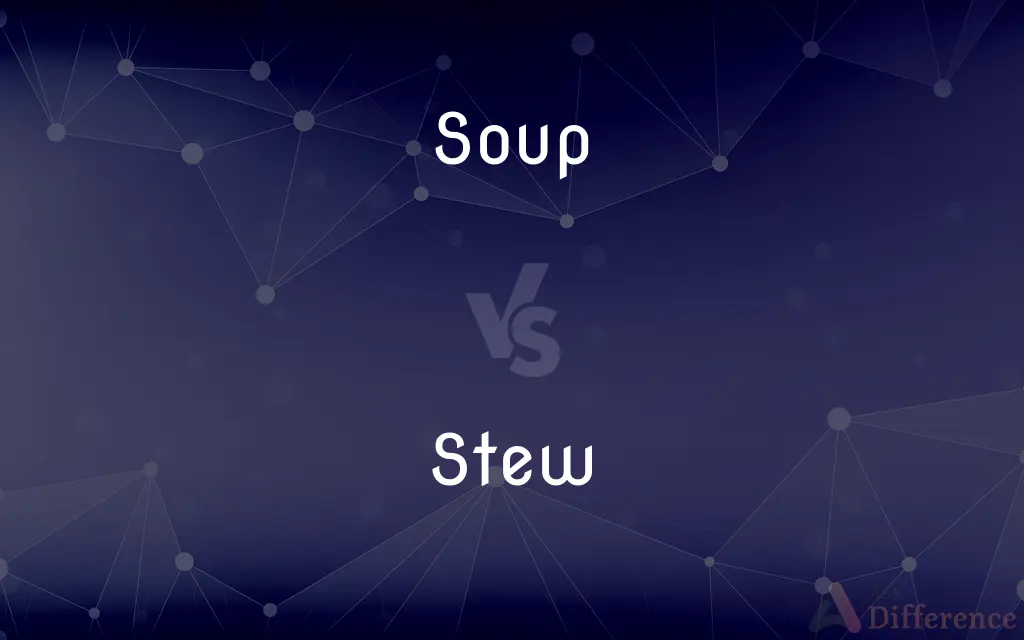Soup vs. Stew — What's the Difference?
By Urooj Arif & Maham Liaqat — Updated on March 12, 2024
Soup is a liquid dish, often thinner, while stew is thicker, with less liquid and more solid ingredients.

Difference Between Soup and Stew
Table of Contents
ADVERTISEMENT
Key Differences
Soup is a primarily liquid food, usually served warm or hot, made by combining ingredients such as meat, vegetables, and stock, water, or another liquid. It can range from clear broths to thick, creamy concoctions, and is often used as a starter or a light meal. Stew, on the other hand, is a dish of meat and vegetables cooked slowly in liquid until the ingredients are very soft and the liquid is thickened, often served as a hearty main course.
The cooking method for soup often involves simmering the ingredients to extract flavor and achieve a desired liquid consistency. Stews, whereas, require a longer cooking time at a lower temperature, allowing the flavors to meld together and the liquid to reduce, resulting in a thicker, more flavorful sauce that coats the solid ingredients.
Soups can be made quickly, with many recipes designed for convenience and speed, making them suitable for a light meal or as part of a multi-course meal. Stews, however, are typically more time-consuming due to the slow cooking process, which develops depth and richness in flavor, making them filling enough to serve as the main dish.
The ingredient ratio in soups leans heavily towards the liquid component, which can include broths, stocks, water, or cream. In contrast, stews have a higher proportion of solid ingredients, such as meat and vegetables, with just enough liquid to cover them, which thickens during the cooking process.
While both soups and stews can be versatile and include a wide variety of ingredients, soups are generally considered lighter fare, whereas stews are viewed as more substantial and comforting, especially in colder weather.
ADVERTISEMENT
Comparison Chart
Consistency
Ranges from thin to creamy, but primarily liquid
Thick, with more solid ingredients and less liquid
Cooking Time
Can be quick, especially for simple broths
Longer cooking time for flavor development
Serving
Often as a starter or light meal
Typically served as a hearty main course
Ingredients
Higher liquid ratio with various components
Larger proportion of solid ingredients
Texture
Generally smoother or with small chunks
Chunky, with ingredients meant to be very soft
Compare with Definitions
Soup
Liquid food served warm or hot.
Chicken noodle soup is a comforting dish for cold days.
Stew
Hearty dish of slowly cooked meat and vegetables.
Beef stew is a filling meal with tender meat and vegetables.
Soup
Variety includes broths, creams, and chowders.
Tomato soup is often served with a dollop of cream for added richness.
Stew
Requires longer cooking for a thick sauce.
A good lamb stew is simmered slowly to thicken the sauce.
Soup
Quick to prepare, suitable for light meals.
A vegetable soup can be made quickly for a healthy dinner.
Stew
Ingredients are meant to be soft and meld together.
The potatoes in the stew should be soft enough to break with a fork.
Soup
Ingredients simmered to extract flavor.
Beef broth is simmered for hours to extract deep flavors.
Stew
Served as a main course, often with bread.
Irish stew is traditionally served with a side of soda bread.
Soup
Often served as a starter in multi-course meals.
A light mushroom soup is an elegant start to a formal dinner.
Stew
Ideal for cold weather, providing warmth and comfort.
A hearty stew is perfect for warming up on a snowy day.
Soup
Soup is a primarily liquid food, generally served warm or hot (but may be cool or cold), that is made by combining ingredients of meat or vegetables with stock, milk, or water. Hot soups are additionally characterized by boiling solid ingredients in liquids in a pot until the flavors are extracted, forming a broth.
Stew
A stew is a combination of solid food ingredients that have been cooked in liquid and served in the resultant gravy. Ingredients in a stew can include any combination of vegetables and may include meat, especially tougher meats suitable for slow-cooking, such as beef, poultry, sausages, and seafood.
Soup
A liquid food prepared from meat, fish, or vegetable stock combined with various other ingredients and often containing solid pieces.
Stew
To cook (food) by simmering or boiling slowly.
Soup
Dense fog.
Stew
To undergo cooking by boiling slowly or simmering.
Soup
Nitroglycerine.
Stew
(Informal) To suffer with oppressive heat or stuffy confinement; swelter.
Soup
Primordial soup.
Stew
(Informal) To be in a state of anxiety or agitation.
Soup
A chaotic or unfortunate situation.
Stew
(obsolete) A cooking-dish used for boiling; a cauldron.
Soup
Any of various dishes commonly made by combining liquids, such as water or stock with other ingredients, such as meat and vegetables, that contribute flavor and texture.
Pho is a traditional Vietnamese soup.
Stew
A heated bath-room or steam-room; also, a hot bath.
Soup
(countable) A serving of such a dish, typically in a bowl.
Stew
(archaic) A brothel.
Soup
(uncountable) The liquid part of such a dish; the broth.
Stew
(obsolete) A prostitute.
Soup
(figuratively) Any mixture or substance suggestive of soup consistency.
Stew
A dish cooked by stewing.
Soup
(slang) Thick fog or cloud (also pea soup).
Stew
An artificial bed of oysters.
Soup
Or gelignite, especially when used for safe-cracking.
Stew
(slang) A state of agitated excitement, worry, and/or confusion.
To be in a stew
Soup
(cant) dope (an illicit drug used for making horses run faster or to change their personality).
Stew
(informal) A steward or stewardess on an airplane or boat.
Soup
(photography) Processing chemicals into which film is dipped, such as developer.
Stew
To cook (food) by slowly boiling or simmering.
I'm going to stew some meat for the casserole.
The meat is stewing nicely.
Soup
(biology) A liquid or gelatinous substrate, especially the mixture of organic compounds that is believed to have played a role in the origin of life on Earth.
Primordial soup
Stew
(transitive) To brew (tea) for too long, so that the flavour becomes too strong.
Soup
An unfortunate situation; trouble, problems (a fix, a mess); chaos.
Stew
To suffer under uncomfortably hot conditions.
Soup
(surfing) The foamy portion of a wave.
Stew
To be in a state of elevated anxiety or anger.
Soup
Alternative form of sup
Stew
A small pond or pool where fish are kept for the table; a vivarium.
Soup
(uncommon) To feed: to provide with soup or a meal.
Stew
An artificial bed of oysters.
Soup
(photography) To develop (film) in a (chemical) developing solution.
Stew
A place of stewing or seething; a place where hot bathes are furnished; a hothouse.
As burning Ætna from his boiling stewDoth belch out flames.
The Lydians were inhibited by Cyrus to use any armor, and give themselves to baths and stews.
Soup
(obsolete) To proselytize by feeding the impoverished as long as they listen to one's preaching.
Stew
A brothel; - usually in the plural.
There be that hate harlots, and never were at the stews.
Soup
Alternative form of sup
Stew
A prostitute.
Soup
(obsolete) To sweep.
Stew
A dish prepared by stewing; as, a stewof pigeons.
Soup
A liquid food of many kinds, usually made by boiling meat and vegetables, or either of them, in water, - commonly seasoned or flavored; strong broth.
Stew
A state of agitating excitement; a state of worry; confusion; as, to be in a stew.
Soup
To sup or swallow.
Stew
To boil slowly, or with the simmering or moderate heat; to seethe; to cook in a little liquid, over a gentle fire, without boiling; as, to stew meat; to stew oysters; to stew apples.
Soup
To breathe out.
Stew
To be seethed or cooked in a slow, gentle manner, or in heat and moisture.
Soup
To sweep. See Sweep, and Swoop.
Stew
Agitation resulting from active worry;
Don't get in a stew
He's in a sweat about exams
Soup
Liquid food especially of meat or fish or vegetable stock often containing pieces of solid food
Stew
Food prepared by stewing especially meat or fish with vegetables
Soup
Any composition having a consistency suggestive of soup
Stew
Be in a huff; be silent or sullen
Soup
An unfortunate situation;
We're in the soup now
Stew
Bear a grudge; harbor ill feelings
Soup
Dope (a racehorse)
Stew
Cook slowly and for a long time in liquid;
Stew the vegetables in wine
Common Curiosities
Is stew always made with meat?
While meat is common, there are vegetarian stews that use hearty vegetables and legumes as the main ingredients.
Can soup be served cold?
Yes, some soups like gazpacho are served cold, especially in warm climates.
What is soup?
Soup is a liquid dish made by combining ingredients like meat and vegetables with stock or water, often served warm.
Are there quick stew recipes?
While traditional stews are slow-cooked, there are quicker versions that use pre-cooked ingredients or pressure cookers to reduce cooking time.
What defines a stew?
Stew is a thick, hearty dish where meat and vegetables are slowly cooked in a minimal amount of liquid until very soft.
Can soups and stews be frozen for later use?
Most soups and stews freeze well, making them convenient for meal prep and reducing food waste.
How can the thickness of a soup be adjusted?
The thickness can be adjusted by adding more liquid for a thinner consistency or by blending part of the soup for a creamier texture.
Can leftovers be used to make soup?
Yes, leftovers are great for making soup, as they can be easily combined with stock or water and additional seasonings.
How important is seasoning in soup and stew?
Seasoning is crucial in both, as it enhances the flavor of the ingredients, especially in soups where the liquid component is significant.
What accompaniments go well with stew?
Stew is often served with bread, rice, or potatoes to soak up the flavorful sauce.
Share Your Discovery

Previous Comparison
Landscape vs. Countryside
Next Comparison
Toast vs. RoastAuthor Spotlight
Written by
Urooj ArifUrooj is a skilled content writer at Ask Difference, known for her exceptional ability to simplify complex topics into engaging and informative content. With a passion for research and a flair for clear, concise writing, she consistently delivers articles that resonate with our diverse audience.
Co-written by
Maham Liaqat














































